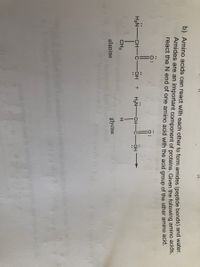
Chemistry
10th Edition
ISBN: 9781305957404
Author: Steven S. Zumdahl, Susan A. Zumdahl, Donald J. DeCoste
Publisher: Cengage Learning
expand_more
expand_more
format_list_bulleted
Question
In the spaces provided below, use Lewis structures to show each entire chemical reaction between the two given reactants. Then, indicate the hybridization of each central atom. Do not name the products

Transcribed Image Text::6:
b) Amino acids can react with each other to form amides (peptide bonds) and water.
Amides are an important component of proteins. Given the following amino acids,
react the N end of one amino acid with the acid group of the other amino acid.
H2N-
CH -C
OH
H2N-
CH-
HO-
CH3
alanine
glycine
Expert Solution
This question has been solved!
Explore an expertly crafted, step-by-step solution for a thorough understanding of key concepts.
Step by stepSolved in 3 steps with 3 images

Knowledge Booster
Learn more about
Need a deep-dive on the concept behind this application? Look no further. Learn more about this topic, chemistry and related others by exploring similar questions and additional content below.Similar questions
- For each of the following molecules, identify whether it is a valid Lewis structure and if not, explain why. Then, regardless of whether it is a valid structure or not, use VSEPR to identify the expected 3-D structure.arrow_forwardFor each of the following molecules, identify whether it is a valid Lewis structure and if not, explain why. Then, regardless of whether it is a valid structure or not, use VSEPR to identify the expected 3-D structure.arrow_forwardH /\ HH H HH C CCH :0: H Identify the type (sigma or pi) of bond and the total number of times it appears in the structure. (Your answer must be a positive whole number...this excludes zero!!!) Note: the C=O oxygen atom's atomic orbitals do not undergo hybridization within this bonding scheme. Total number of times it appears: Csp3 - Csp2arrow_forward
- In the molecule shown below, predict the type of hybrid orbitals used by each atom? Question options: (σ-bond), C atom = Sp, (π-bond), C atom = 2p (σ-bond), C atom = Sp2, (π-bond), C atom = Sp2 (σ-bond), C atom = Sp2, (π-bond), C atom = 2p (σ-bond), C atom = Sp3, (π-bond), C atom = Sp2arrow_forwardWhat is the hybridization of the orbitals involved in bonding interactions associated with acetic acid (CHSCOOH). Hint; Draw the Lewis structure. Answer: sp3, sp2, sp3darrow_forward3. Predict (a) the approximate bond angle, (b) the hybridization around the indicated atoms (the atoms to which the arrows are drawn in the structures below). Write your answers near the corresponding labels (1 to 5) in the drawings. (Note: the lone pairs on the F atoms are omitted for clarity.) H. 1 F 2 4 F Br -F С -о-н F F 'N : 1: 2: 3: 4: 5:arrow_forward
- The Lewis structure of an organic compound is shown below. Determine the orbitals used in bonding, as well as the number of sigma and pi bonds. 1ペー= 10 H 5. :N. 11 Total sigma bonds: [Select ] Total pi bonds: [Select] Write "none" if no orbital of that type is used to bond. Unhybridizedorbital used to Hybridized orbital used to Atom bond bond H. [ Select ] [Select] [ Select ] [ Select] N C #2 [ Select] [ Select] [ Select ] [ Select ]arrow_forwardPlease solve thisarrow_forward16arrow_forward
- For the indicated atoms, what is their hybridization? In what orbital do the lone pairs reside?arrow_forward1. Concept map: For carbon, draw out the orbital energy diagram of sp³, sp², and sp hybridized orbitals, including the leftover unhybridized orbitals, if any.arrow_forwardNumber of Molecule valence electrons Formal Charge Electron-Group Geometry Molecular Geometry Resonance SiSeH2 Si: Si: Select one ... Si: Select one ... Select one ... AIHCI2l" Al: Al: Select one ... Al: Select one ... Select one.. AsSel3 As: As: Select one ... As: Select one ... Select one ... AIH2CI- Al: Al: Select one ... Al: Select one .. Select one.. PTEF3 P: P: Select one ... P: Select one ... Select one ...arrow_forward
arrow_back_ios
SEE MORE QUESTIONS
arrow_forward_ios
Recommended textbooks for you
 ChemistryChemistryISBN:9781305957404Author:Steven S. Zumdahl, Susan A. Zumdahl, Donald J. DeCostePublisher:Cengage Learning
ChemistryChemistryISBN:9781305957404Author:Steven S. Zumdahl, Susan A. Zumdahl, Donald J. DeCostePublisher:Cengage Learning ChemistryChemistryISBN:9781259911156Author:Raymond Chang Dr., Jason Overby ProfessorPublisher:McGraw-Hill Education
ChemistryChemistryISBN:9781259911156Author:Raymond Chang Dr., Jason Overby ProfessorPublisher:McGraw-Hill Education Principles of Instrumental AnalysisChemistryISBN:9781305577213Author:Douglas A. Skoog, F. James Holler, Stanley R. CrouchPublisher:Cengage Learning
Principles of Instrumental AnalysisChemistryISBN:9781305577213Author:Douglas A. Skoog, F. James Holler, Stanley R. CrouchPublisher:Cengage Learning Organic ChemistryChemistryISBN:9780078021558Author:Janice Gorzynski Smith Dr.Publisher:McGraw-Hill Education
Organic ChemistryChemistryISBN:9780078021558Author:Janice Gorzynski Smith Dr.Publisher:McGraw-Hill Education Chemistry: Principles and ReactionsChemistryISBN:9781305079373Author:William L. Masterton, Cecile N. HurleyPublisher:Cengage Learning
Chemistry: Principles and ReactionsChemistryISBN:9781305079373Author:William L. Masterton, Cecile N. HurleyPublisher:Cengage Learning Elementary Principles of Chemical Processes, Bind...ChemistryISBN:9781118431221Author:Richard M. Felder, Ronald W. Rousseau, Lisa G. BullardPublisher:WILEY
Elementary Principles of Chemical Processes, Bind...ChemistryISBN:9781118431221Author:Richard M. Felder, Ronald W. Rousseau, Lisa G. BullardPublisher:WILEY

Chemistry
Chemistry
ISBN:9781305957404
Author:Steven S. Zumdahl, Susan A. Zumdahl, Donald J. DeCoste
Publisher:Cengage Learning

Chemistry
Chemistry
ISBN:9781259911156
Author:Raymond Chang Dr., Jason Overby Professor
Publisher:McGraw-Hill Education

Principles of Instrumental Analysis
Chemistry
ISBN:9781305577213
Author:Douglas A. Skoog, F. James Holler, Stanley R. Crouch
Publisher:Cengage Learning

Organic Chemistry
Chemistry
ISBN:9780078021558
Author:Janice Gorzynski Smith Dr.
Publisher:McGraw-Hill Education

Chemistry: Principles and Reactions
Chemistry
ISBN:9781305079373
Author:William L. Masterton, Cecile N. Hurley
Publisher:Cengage Learning

Elementary Principles of Chemical Processes, Bind...
Chemistry
ISBN:9781118431221
Author:Richard M. Felder, Ronald W. Rousseau, Lisa G. Bullard
Publisher:WILEY